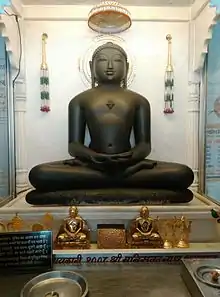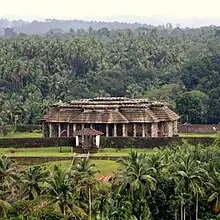| Munisuvrata | |
|---|---|
20th Tirthankara | |
| Member of Tirthankara, Shalakapurusha, Arihant and Siddha | |
 Idol of Munisuvrata at Manilaxmi Jain temple, Gujarat | |
| Venerated in | Jainism |
| Predecessor | Mallinatha |
| Successor | Naminatha |
| Symbol | Tortoise[1] |
| Age | 30,000 |
| Color | Black |
| Gender | Male |
| Personal information | |
| Born | |
| Died | |
| Parents |
|
| Part of a series on |
| Jainism |
|---|
 |
Munisuvrata or Munisuvratanatha (IAST: Munisuvratanātha) (Devanagari: मुनिसुव्रतनाथ) (Sanskrit: मुनिसुव्रतः) was the twentieth tirthankara of the present half time cycle (avasarpini) in Jain cosmology. He became a siddha, a liberated soul which has destroyed all of his karma. Events of the Jaina version of Ramayana are placed at the time of Munisuvrata. Munisuvrata lived for over 30,000 years. His chief apostle (gaṇadhara) was sage Malli Svāmi.
Legends
Munisuvrata was the twentieth tirthankara of the present half time cycle (avasarpini) in Jain cosmology.[2] Jain texts like padmapurana place him as a contemporary of Rama.[3][4] According to Jain texts, Munisuvrata was born as 54 lakh years passed after the birth of the nineteenth tirthankara, Mallinātha.[5] According to Jain beliefs, Munisuvrata descended from the heaven called Ānata kalpa on the twelfth day of the bright half of the month of Āśvina – āśvina śukla dvādaśi– to queen Padmavati and king Sumitra.[6][7] On the third day of Shraavana (month) Krishna (dark fortnight) according to Hindu calendar, queen Padmavati of Rajgir saw sixteen auspicious dreams. When she shared her dreams with her husband, king Sumitra of the Harivamsa clan, he explained that a tirthankara will be born to them soon. Then, Munisuvrata was born to them on the fifteenth day of the Shraavana Shukla (bright fortnight) in 1,184,980 BC.[2][8] His height is mentioned to be 20 bows (60 metres) and complexion as a dark one.[6][9]
According to Jain texts, after spending 7,500 years as a youth, Munisuvrata is believed to have ruled his kingdom for 15,000 years (rājyakāla). He then renounced all worldly pursuits and became a monk. According to Jain beliefs, he spent 11 months performing karma-destroying austerities and then attained the all-embracing knowledge – Omniscience (kevala jñāna) under a Champaka tree.[10][6] He is said to have 18 ganadharas headed by Malli. Puspavati or Puspadatta is believed to be the head-nun of his order.[6] Samayavayanga sutra, however, names Kumbha and Amila as the head ganadhara and head nun respectively.[6]
Munisuvrata is said to have lived for over 30,000 years and attained liberation (nirvāña) from Sammeda śikhara on the twelfth day of the dark half of the month of phālguna – phālguna kṛṣna dvādaśi.[6][10] Varuna is mentioned to be his yaksha and his yakhsini is named Bahurupini in Digambara tradition and Naradatta in Svetambara tradition.[6]
Munisuvrata finds mentions in Jain texts like Uttarapurana and Tiloyapannati.[6]
Adoration
Svayambhustotra by Acharya Samantabhadra is the adoration of twenty-four tirthankaras. Its five slokas (aphorisms) adore the qualities of Munisuvrata.[11]
O Lord Munisuvratanātha! You had attained the excellent observance of the vows of the sages; you are the ascetic supreme, and utterly pristine (having destroyed the inimical karmas). You stood out in the assembly of the sages like the moon in the midst of the constellations of stars.
— Svayambhūstotra (20-1-111)[12]
An idol of Munisuvrata was installed in 127 AD or 157 AD in the Devanirmita stupa, Mathura.[6]
Iconography
Munisuvrata is usually depicted in a sitting (or standing) meditative pose, with a tortoise symbol beneath him;[13] each tīrthankara has a distinct emblem, which allows worshippers to distinguish similar idols.[14] Jivantasvami represents Munisuvrata as a princely state. The Jina is represented as standing in the kayotsarga pose wearing crown and ornaments.[15]
Colossal statues
- Statue of Purity is a 151 feet (46 m) statue dedicated to Munisuvrata under construction in Bhora Kalan, Haryana.[16]
- A 54 feet (16 m) black stone statue of Munisuvrata was installed in Jainaragutti near Adagur in the state of Karnataka.[17]
- A 27 feet (8.2 m) idolf of Munisuvrata is installed near the Shantinath Jain Teerth, Maharashtra.
 State Museum Bhopal, 6th century
State Museum Bhopal, 6th century Image of Munisuvratanatha (Jahazpur district, Bhilwara)
Image of Munisuvratanatha (Jahazpur district, Bhilwara) 12th Century (1153 AD), hasteda, Rajasthan
12th Century (1153 AD), hasteda, Rajasthan Munisuvrata, 1466 CE, Western India, National Museum, New Delhi
Munisuvrata, 1466 CE, Western India, National Museum, New Delhi
Main Temples
- Chaturmukha Basadi is a famous Jain temple located at Karkala in the Indian state of Karnataka. The temple is dedicated to Tirthankara Aranatha, Māllīnātha and Munisuvrata.[18]
- Shri Munisuvrata-Nemi-Parshva Jinalaya located at Santhu, Rajasthan
- Paithan Jain Tirth
- Keshoraipatan Jain temple
- Shri 1008 Munisuvratnath Digambar Jain Atishay Kshetra SwastiDham
- Shantinath Jain Teerth, Indapur
 Chaturmukha Basadi
Chaturmukha Basadi Shri Munisuvrata-Nemi-Parshva Jinalaya at Santhu
Shri Munisuvrata-Nemi-Parshva Jinalaya at Santhu Naulakha Mandir, Rajgir
Naulakha Mandir, Rajgir.jpg.webp) Hasteda, Jain temple
Hasteda, Jain temple
See also
References
Citations
- ↑ Tandon 2002, p. 45.
- 1 2 Tukol 1980, p. 31.
- ↑ Natubhai Shah 2004, pp. 21–23.
- ↑ Zvelebil 1992, p. 65.
- ↑ Vijay K. Jain 2015, p. 203.
- 1 2 3 4 5 6 7 8 9 Umakant P. Shah 1987, p. 161.
- ↑ Vijay K. Jain 2015, p. 203-204.
- ↑ Zimmer 1953, p. 226.
- ↑ Sarasvati 1970, p. 444.
- 1 2 Vijay K. Jain 2015, p. 204.
- ↑ Vijay K. Jain 2015, p. 138-142.
- ↑ Vijay K. Jain 2015, p. 138.
- ↑ Umakant P. Shah 1987, p. 162.
- ↑ Zimmer 1953, p. 225.
- ↑ Umakant P. Shah 1987, p. 163.
- ↑ "हरियाणा में बनेगी मुनिसुव्रत भगवान की 151 फीट ऊंची अष्टधातु की प्रतिमा". Dainik Bhaskar (in Hindi). Retrieved 30 December 2020.
- ↑ "A new Jain pilgrim centre". The Hindu. 19 June 2022.
- ↑ Sandhya, C D’Souza (19 November 2010), "Chaturmukha Basadi: Four doors to divinity Last updated", Deccan Herald
Sources
- Jain, Vijay K. (2015), Acarya Samantabhadra's Svayambhustotra: Adoration of The Twenty-four Tirthankara, Vikalp Printers, ISBN 978-81-903639-7-6, archived from the original on 16 September 2015,
 This article incorporates text from this source, which is in the public domain.
This article incorporates text from this source, which is in the public domain. - Sarasvati, Swami Dayananda (1970), An English translation of the Satyarth Prakash, Swami Dayananda Sarasvati
- Shah, Natubhai (2004) [First published in 1998], Jainism: The World of Conquerors, vol. I, Motilal Banarsidass, ISBN 81-208-1938-1
- Shah, Umakant Premanand (1987), Jaina-rūpa-maṇḍana: Jaina iconography, Abhinav Publications, ISBN 978-81-7017-208-6
- Tandon, Om Prakash (2002) [1968], Jaina Shrines in India (1 ed.), New Delhi: Publications Division, Ministry of Information and Broadcasting, Government of India, ISBN 81-230-1013-3
- Tukol, T. K. (1980), Compendium of Jainism, Dharwad: University of Karnataka
- Zimmer, Heinrich (1953) [April 1952], Campbell, Joseph (ed.), Philosophies Of India, London: Routledge & Kegan Paul Ltd, ISBN 978-81-208-0739-6
- Zvelebil, Kamil (1992), Companion Studies to the History of Tamil Literature, Netherlands, ISBN 90-04-09365-6
{{citation}}: CS1 maint: location missing publisher (link)